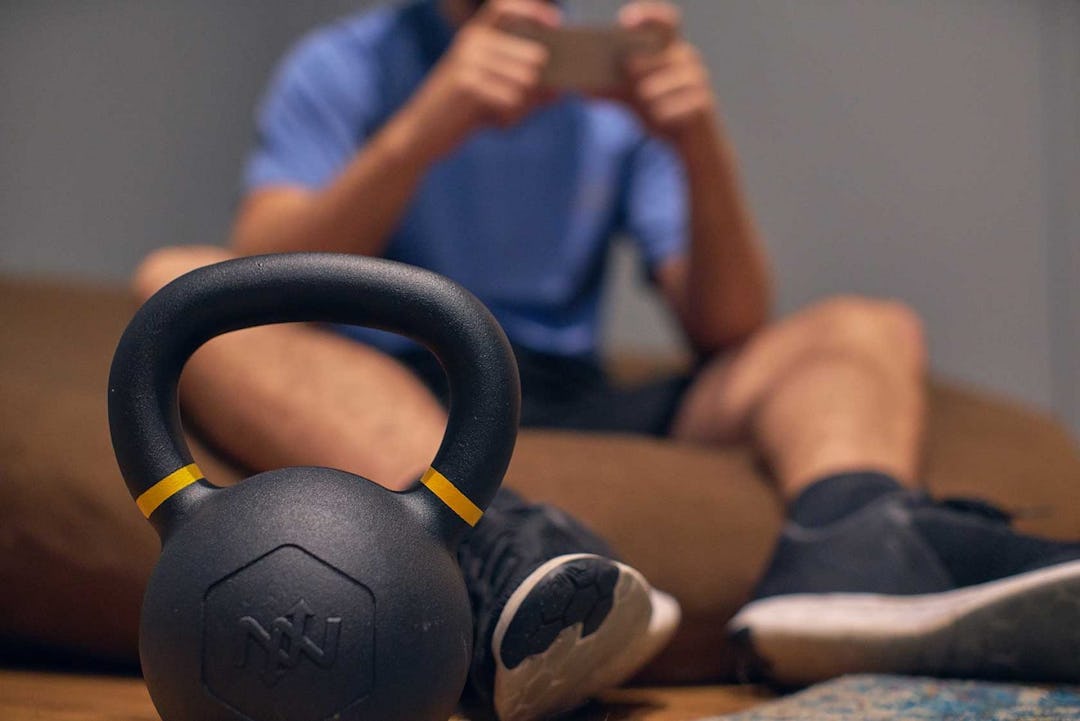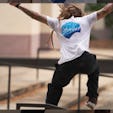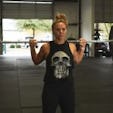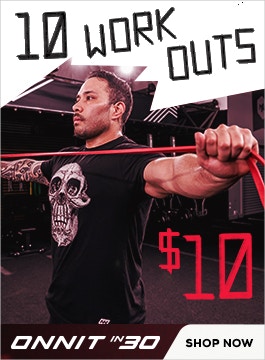It’s easy to look at kettlebell masters such as Primal Swoledier Eric Leija and get inspired. A well-ordered kettlebell flow can be as beautiful and sophisticated as a ballet (or, if you prefer, a choreographed fight scene in a blockbuster action movie). But it’s important to realize that no one starts there—not even an Eric Leija. To get good at kettlebells, and build all the muscle, power, and athleticism that comes with them, you have to master the basics.
Fortunately, it won’t take long if you start with the workout provided here by Onnit Chief Fitness Officer John Wolf. It requires only one kettlebell, and works the entire body. You’ll get all the major benefits of much flashier kettlebell routines, but in a workout that leaves less room for error (or injury), so you can improve quickly and graduate from beginner to the next level faster.
Full-Body Kettlebell Workout For Beginners
Becoming a kettlebell master starts with owning five basic movement patterns. You have to be able to press, row, hinge at the hips, squat, and rotate your body—as well as resist unwanted rotation—while keeping your body in good alignment so that your movements are efficient, effective, and safe. The workout provided here, designed by Onnit’s former Chief Fitness Officer John Wolf, includes the simplest examples of all of these movement patterns, but don’t think that means “easy.” The strongest kettlebell lifters in the world—including Wolf himself—still do these exact exercises, so treat them with respect.
You will perform the following.
– Goblet squat
– One-arm row
– One-arm press
– Chest-loaded swing
– Shoulder and hip halo
– Figure-8 pass
Note that we’re not having you do the full kettlebell swing—even though we’re well aware that it’s one of the most popular kettlebell exercises, and often found in beginner routines. Rather, we’ve modified it to a version that is more user-friendly, but still challenging, and will allow someone of any experience level to train safely and with optimal form. The chest-loaded swing gives you more control over the kettlebell while strengthening your upper back, setting you up to do the full swing with better technique in the near future.
Along the same lines, the halo and figure-eight leg pass may not feel like serious strength training, but they serve a very important purpose. Both will help get your body familiar with rotational movements, so that when you attempt cleans, snatches and other exercises that feature more twists and turns down the road, they don’t feel totally foreign to you. Though halos and passes may seem almost overly simplistic, they’ll help you learn flashier techniques later—we promise—so don’t skip them.
In short, our beginner’s workout is designed to improve your familiarity with the kettlebell while building strength and endurance. It covers the prerequisites you need in order to eventually perform fancier moves like full kettlebell swings, cleans, snatches, and the kind of rotational movements that ultimately lead to impressive exercise sequences like kettlebell flows.
Best of all, you only need one kettlebell to do the workout. An eight kilogram bell is enough for most women, and a 16kg is good for men.
DIRECTIONS
Perform the exercises as a circuit, completing one set of each move in sequence without rest in between. When you’ve completed the entire circuit, rest 1–2 minutes, and then repeat the circuit for 3 total rounds. You can repeat the workout for up to three sessions per week, resting at least a day between sessions. For example, you could do the workout Monday, Wednesday, and Friday.
Try to improve some aspect of your performance every time you repeat the workout. This could mean tightening up your form, adding a rep or two to a set of one or more of the exercises, or cutting down on your rest periods.
1. Kettlebell Goblet Squat
SEE 2:07 IN THE VIDEO ABOVE
Reps: 10
Step 1. Hold the kettlebell by its horns and drive your shoulder blades together and downward so your chest is open (think “proud chest”). Tuck your elbows in so your forearms are as vertical as possible. Stand with feet a bit wider than hip-width apart, and your toes turned out slightly. Take a deep breath into your belly, and twist your feet into the floor (imagine screwing them down without shifting their position).
Step 2. Now squat, keeping your spine long and your torso upright. Go as low as you can without your tailbone tucking under your butt.
Step 3. Exhale as you extend your hips and knees to stand up tall again.
2. Kettlebell One-Arm Row
SEE 3:12 IN THE VIDEO ABOVE
Reps: 8 (each side)
Step 1. Place the kettlebell on the floor and take a staggered stance with your left foot in front and planted just outside the weight. The toes on both feet should face straight forward. Dig the ball of your right foot into the floor behind you, and bend at the hips so your torso is angled about 45 degrees to the floor. Rest your left elbow on your thigh for support, and reach for the kettlebell with your right hand. Take a deep breath into your belly, and brace your core.
Step 2. Exhale as you row the kettlebell to your hip. Draw your shoulder blade back and down as you pull, and avoid twisting your torso—keep your shoulders square to the floor.
Step 3. Lower the weight under control. Complete all your reps on that side, and then repeat on the other side.
3. Kettlebell One-Arm Press
SEE 5:16 IN THE VIDEO ABOVE
Reps: 5 (each side)
Step 1. Stand tall, holding the kettlebell in one hand at shoulder level. Root your feet into the floor as if you were preparing for someone to push you. Draw your shoulder blades down and back—think, “proud chest”— pull your ribs down, and brace your core. Take a deep breath into your belly.
Step 2. Exhale as you press the weight overhead with your forearm vertical. Your elbow will naturally move away from your side and the press will feel like an “around the world” motion—that’s OK. Note that your chin should be pulled back so that weight has no trouble clearing it.
Step 3. To lower the kettlebell, pull it back down into position—as if you were performing a pullup. Complete all your reps on that side, and then repeat on the other side.
4. Kettlebell Chest-Loaded Swing
Reps: 15
Step 1. Stand with feet between hip and shoulder width, and root your feet. Hold the kettlebell by its horns, pulling the bottom of the bell into your lower sternum. Draw your shoulder blades together and down (“proud chest”), and cast your eyes on a spot on the floor approximately 15 feet in front of you. Take a deep breath into your belly, and brace your core.
Step 2. Tilt your tailbone upward slightly (so your pelvis tips forward a bit). Keeping a long spine, bend your hips straight back, as if you were trying to touch your butt to the wall behind you. Allow your knees to bend as needed.
Step 3. When you feel a stretch in your hamstrings, exhale, and extend your hips and squeeze your glutes, tucking your tailbone under as you lock out your hips.
5. Kettlebell Shoulder Halo
Reps: 8 (each direction)
Step 1. Stand with feet between hip and shoulder-width, and hold the kettlebell by its horns upside down—the bell’s bottom should face up. Screw your feet into the floor, get into your proud-chest position, lick your ribs down, and brace your core. Take a deep breath into your belly.
Step 2: Exhale as you begin moving the kettlebell around your head, being careful to maintain your posture and not bend your torso in any direction. Move slowly to avoid whacking yourself in the head. Make a full circle, and then repeat in the opposite direction. Continue alternating directions on each rep.
6. Kettlebell Hip Pass
Reps: 8 (each direction)
Step 1. Set up as you did for the shoulder halo but hold the kettlebell by the handle at arm’s length in one hand and make circles around your hips, passing the bell to the other hand and then back again. Perform eight reps in one direction, and then repeat in the opposite direction.
7. Kettlebell Figure-8
Reps: 5 (each direction)
Step 1. Place the kettlebell on the floor, and stand behind it with feet between hip and shoulder width. Keeping a long spine, bend your hips back, allowing your knees to bend as needed until you can grasp the kettlebell with one hand. Get a proud chest, and take a deep breath into your belly.
Step 2. Extend your hips just enough to lift the weight off the floor, and pass it back between your legs to the opposite hand. Move the bell around your leg to the front of your body and back through your legs again to pass it back to the other hand. Continue passing the kettlebell back and forth in a figure-eight motion. Be sure to keep your knees bent so that you’re low to the floor and keeping tension on your quads the whole time.
8. Kettlebell Chest-Loaded Swing
Reps: 15
Repeat the swings as described above.
Best Kettlebell Exercise Alternatives
Beginners to kettlebell training, as well as those with shoulder mobility challenges or shoulder injuries, may have difficulty performing the one-arm overhead press. If you find that you can’t fully lock out your elbow without hyperextending your back and flaring your ribs, or you simply can’t extend your elbow much past 90 degrees, count yourself in this group. But that’s OK, says Wolf. “Don’t get fixated on achieving a full overhead lockout right away. Just going to where your elbow is bent 90 degrees and holding it isometrically is a ton of work for most people.”
In other words, one alternative to the one-arm kettlebell press shown above is to simply press the weight up to a 90-degree elbow bend and hold it two to three seconds. That’s one rep. Over time, you’ll get stronger in that range of motion, and you’ll be able to lock out your elbow while keeping the rest of your body in check (that is, maintain all the other form points described above).
Another option is to regress the movement to a floor press—lie down on the floor and press the weight from your chest (think of it as a bench press with a shortened range of motion). The floor provides the stability your shoulder and core need, so you can focus purely on pressing. It’s a safer alternative to overhead pressing that will strengthen your upper-body muscles while you work on the shoulder mobility/stability and core strength you need to get back to the classic overhead press.
Kettlebell One-Arm Floor Press
SEE 8:55 IN THE VIDEO ABOVE
Step 1. Lie on your back on the floor with a kettlebell in one hand. Bend your knees and plant your feet; flatten your lower back into the floor, brace your core, and squeeze your glutes. Position your working arm 45 degrees to your side, bend the elbow 90 degrees, and drive your elbow into the floor to create stability. Use your free arm to help you lift the kettlebell overhead so your set starts at the top of the movement.
Step 2. Lower your arm until your triceps touch the floor, but not the elbow (don’t let your elbow crash down). Pause a moment under tension, and then press the kettlebell back overhead.
Benefits of Kettlebell Workouts
If you’re not sure exactly what training with kettlebells can do for you, here’s a rundown of the selling points.
Good Form
Kettlebell training builds muscle and strength like any other type of resistance training, but it’s especially good for developing body awareness and good movement skills at the same time, and that will transfer over to any other kind of training or athletic activity you’re interested in.
The reason why lies in the kettlebell’s design. The center of gravity (the bell itself) is displaced six to eight inches away from the handle you grip, and that makes it harder to control than a dumbbell, barbell, and most other conventional training implements. Almost any exercise you do, then, is going to require you to keep stricter form in order to perform it correctly, and your body will have to activate more overall muscle to get it done.
Imagine a kettlebell overhead press. Because the weight hangs at a distance from the handle, it will tempt your arm to drift backward as you press. You have to concentrate on controlling your shoulder to the max in order to press the weight straight up, and that not only builds bigger, stronger shoulders, but also makes you better at the skill of shoulder pressing.
Most kettlebell exercises expose your weaknesses right away. If you feel your lower back hyperextending and your ribs flaring while you press, you know you have to work on keeping your core tight, and you may need extra shoulder and T-spine mobility training as well. Many people will do barbell back squats and allow their chests to fall forward, their knees to cave inward, and their heels to come off the floor. But when you do a goblet squat with a kettlebell, it’s easy to see and feel a correct rep versus a sloppy one.
Core and Grip Strength
The kettlebell’s offset loading also ensures that virtually any exercise you do will be a core exercise, as your core keeps your whole body from getting pulled out of alignment. Meanwhile, the kettlebell’s handle is slicker and less accommodating than a dumbbell’s, meaning that your grip/forearm muscles will have to clamp down harder—so kettlebells are great for building an iron handshake and the ability to hold on tight.
Improved Athleticism
There are virtually no isolation exercises that you can perform with a kettlebell (such as biceps curls, leg extensions, etc.). Most movements you’ll do train nearly the whole body at once, and that teaches it to work as a unit—the way it does when you’re playing a sport. Furthermore, kettlebells lend themselves to explosive movements like swings and cleans, which develop power (particularly in the hips, which are key for jumping and running). Kettlebells also give you the opportunity to train in multiple movement planes— sometimes all at once—preparing you for the exact mechanics and sudden changes of direction you use in all kinds of sports. You can string exercises together, as in a kettlebell flow, to practice being explosive and strong in all directions—a feature you certainly don’t get with barbells and dumbbells.
Research is beginning to catch up with kettlebell coaches, confirming what they’ve known for years. A review of five studies in Physical Therapy Reviews suggests that kettlebell training is safe and effective for boosting functional strength and power, and may improve postural control as well. Another study from the Journal of Strength and Conditioning Research showed that a kettlebell workout burned more calories than a sprint cycling session, making it the more desirable and sustainable cardio option for many people.
Finally, an American Council on Exercise study put a group of fit people with strength-training experience on an eight-week kettlebell program. Not only did they gain strength (including a 70% jump in core strength), but they also improved aerobic capacity—by 13.8%—and dynamic balance. Lead researcher John Porcari, PhD, summarized the findings as follows: “You don’t really do resistance training expecting to get an aerobic capacity benefit… But with kettlebells, you’re able to get a wide variety of benefits with one pretty intense workout.”
Efficient Training
Whereas you may need several pairs of dumbbells to get a full-body workout, you can do the job with only one or two weight increments when you use kettlebells, and the workout we offer here requires only one kettlebell on its own. “There’s a huge library of exercises that you can access with one weight,” says John Wolf, Onnit’s Chief Fitness Officer. “I’ve always said that if you have one kettlebell in the corner of your room, you basically have a gym.”
What Muscles Do Kettlebells Work
One of the reasons kettlebell training is so effective is that it works everything. You don’t need to think about whether you’ve done enough work for one muscle or another, because in a well-balanced kettlebell workout, you’re sure to cover them all. As discussed earlier, kettlebell training is particularly demanding of the core and the grip, so you can be sure your abs and forearm muscles will get stimulated no matter what exercises you perform.
Any full-body kettlebell workout should include some squatting, hip-hinging, pressing, rowing and rotational movements (you’ll find them all in the workout we offer below). That means that you’ll train every major muscle group in the body, but, to be more specific, we’ll break down what those movement patterns train one at a time.
Note that the list below covers only the major contributing muscles. Understand that there is also a lot of overlap between movements. For instance, hinge exercises work many of the same muscles as squatting exercises and even pressing movements, so to avoid repeating ourselves, we list the muscles that are primary targets for each movement pattern only.
Squatting
– Quads
– Inner thigh (adductors)
Hinging
– Glutes
– Lower back (spinal erectors)
– Core (rectus abdominis, transverse abdominis)
Pressing
– Shoulders (anterior and lateral deltoids)
– Chest (particularly upper chest, or, the clavicular head)
– Triceps
Rowing
– Shoulders (rear deltoid)
– Upper back (trapezius, rhomboids, lats, teres major)
– Biceps
– Forearms (brachioradialis, wrist flexors)
Rotation
– Core (obliques)
How To Stretch Before A Full-Body Kettlebell Workout
Many people believe they need to stretch before a workout in order to perform it safely, but this is only partly true. You’ll get a more effective warmup by performing a few mobility drills—a combination of stretching and more dynamic movements. Mobility work prepares your joints for the ranges of motion you’ll use on your exercises while also raising your core temperature and driving blood into the muscles you’ll be working. For any full-body kettlebell routine, you’ll want to focus specifically on preparing the shoulders, T-spine, and hips, which the following moves cover.
Perform the drills as a circuit, completing 3–5 reps of each in sequence, and then repeat for up to 3 rounds total.
1. Straight-Leg Hip Circle
Step 1. Hold onto a sturdy object for support, and raise one leg up in the air 90 degrees. Keep the knee as straight as you can.
Step 2. Keeping your shoulders facing forward, draw your leg outward and away from you to the side. When you feel you’re running out of range, begin turning your foot over to face the floor. Exhale as you do so.
Step 3. When you’ve made a complete circle with your leg, return your foot to the floor, and then repeat in the opposite direction. That’s one rep. Complete all your reps on that side, and then switch legs.
2. Push-Pull Drill
Step 1. Stand tall and inhale deeply as you draw your elbows as far back as possible with palms facing up.
Step 2. Exhale fully as you push your palms away from you, and rotate them so your fingers point up. Spread your shoulder blades apart as you do so, rounding your upper back. That’s one rep.
3. Hip-Opening Mountain Climber
Step 1. Get into a pushup position with hands directly beneath your shoulders and legs extended behind you, feet shoulder-width apart. Tuck your tailbone and brace your core—your head, spine, and pelvis should form a straight line. Draw your shoulder blades back together and downward. Think: “proud chest,” and “long spine.” Take a deep breath.
Step 2. Exhale your breath and, keeping your core braced, raise your right leg to the outside of your right arm, landing with your foot flat and the knee pointed straight ahead. Try to maintain your spine and pelvis alignment as you do this. It’s OK if you can’t do it perfectly now, but be aware of how you’re moving so you can correct it. When your leg is in position, pull it inward while driving your right arm out so it touches the outside of your arm firmly.
Step 3. Allow your hips to sink a bit and adjust so you re-establish your proud chest and long spine position. Hold for 3–5 seconds.
Step 4. Return your right leg back to the original pushup position, and repeat on the opposite leg. That’s one rep of each.
4. Sky Reach To Arm Thread
Step 1. Get on all fours with your hands under your shoulders and your knees directly beneath your hips. Brace your core.
Step 2. Inhale as you draw your right arm up and across your chest, twisting your right shoulder toward the ceiling and reaching overhead. Be careful to keep your hips facing the floor.
Step 3. Exhale as you reverse the motion, reaching your arm across your body and behind the support arm. Twist as far as you can, ideally until the back of your right shoulder touches the floor. That’s one rep. Complete your reps on that side, and then switch sides.
5. Arm Screw
Step 1. Stand tall and reach your arms out to your sides. Inhale as you lift your right shoulder toward your ear, and turn the front of your right shoulder toward your chest as you rotate your arm inward. This will cause your torso to twist to the left.
Step 2. Continue rotating your right arm, twisting it like you’re wringing out a sponge until your right palm is facing upward (or as close as you can get it). Exhale. At the same time, reach your left arm out, palm facing up. Allow your torso to bend to the left as you reach.
Step 3. Return to the starting position and repeat on the other side. That’s one rep.
Next Level Single-Kettlebell, Full-Body Workout
Here’s another workout you can do with a single piece of iron, courtesy of Juan Leija, former Director of Fitness Programming at Onnit (@juannit_247 on Instagram). It not only offers strength training but also includes a warmup, and, at the end, a conditioning circuit to burn fat and build endurance. See the video above where he walks friend, two-time Highland Games champ, and Onnit Pro Athlete Matt Vincent (@matthewpvincent on Instagram) through the routine, and scroll down to see the program in writing.
DIRECTIONS
Warmup
Perform two sets of the single-kettlebell halo, followed by two sets of the Turkish getup.
Single-Kettlebell Halo
Sets: 2 Reps: 5–10 (each direction)
[See 0:35 in the video above]
Hold the kettlebell by the horns (the sides of the handle) and begin circling it around your head. Make one complete revolution, and then switch directions. Each circle is one rep. Keep your ribs down and your pelvis level with the floor. Brace your core.
Turkish Getup
Sets: 2 Reps 2 (each side)
[See 0:45 in the video]
Step 1. Lie on your back and hold the kettlebell over your chest with your left hand. Bend your left knee and plant that foot. Extend your right arm out at 45 degrees and push your hand into the floor for stability.
Step 2. Roll your torso up off the floor, using your right arm for support. Keep the kettlebell overhead and pointing to the ceiling. Drive your left foot into the floor to bridge your hips up, and swing your right leg under you to rest on your right knee.
Step 3. Windshield wiper the right lower leg so it’s in line with the left leg, and you’re resting in the bottom of a lunge.
Step 4. Stand up tall, with the weight still raised overhead.
Step 5. Reverse the steps to return to the floor. Complete 2 reps on that side and then 2 on the other. That’s one set.
Remember, if your kettlebell is extra heavy, you don’t have to use it for the Turkish getup. Just your bodyweight is enough to get warmed up.
CNS Prep
Doing some explosive exercises before you lift heavy will help to warm up your central nervous system, allowing you to better activate the muscle fibers you need to get the most out of your strength work. It will also help to wake you up, increasing alertness if you’re feeling a little groggy or distracted.
Perform two rounds of the kettlebell swing and speed pushup back to back. That is, do a set of the swings and then the pushups. Rest a minute, and repeat once more.
Kettlebell Swing
Sets: 2 Reps: 5
[See 4:10 in the video above]
Click here for a full tutorial on the kettlebell swing.
Speed Pushup
Sets: 2 Reps: 5
[See 4:47 in the video]
Step 1. Place your hands at shoulder width and your feet close together. Brace your core.
Step 2. As you lower your body, tuck your elbows about 45 degrees to your sides so that your head and arms form an arrow shape. Go until your chest is about an inch above the floor, and then press up explosively. Perform the reps as fast as possible.
Strength
Do all the reps for one side of your body, rest, and then work the other side. Repeat for two total sets on each side. Rest 1–2 minutes between all sets (unless you have to modify the intensity as described above).
Complete all the sets for one exercise before you go on to the next one.
Sets: 2 (each side) Reps: 5 (each side)
[See 5:43 in the video above]
Click here for our tutorial on the kettlebell clean.
2. Single-Rack Squat
Sets: 2 (each side) Reps: 8 (each side)
[See 7:28 in the video]
Step 1. Clean the kettlebell up to the rack position and stand with feet about shoulder-width apart with toes turned out slightly.
Step 2. Imagine screwing your feet into the floor by turning them outward, but don’t move them out of position. You want to feel the muscles in your hips and glutes turn on. Now squat as deeply as you can while keeping your torso upright—stop before you feel your tailbone tuck under. Your knees should track over your big toes. Be sure to brace your core to avoid bending toward the side that’s holding the weight.
Step 3. Extend your hips and knees to stand up tall.
3. Kettlebell Push Press
Sets: 2 (each side) Reps: 5 (each side)
[See 9:00 in the video]
Step 1. Hold the weight at shoulder level and stand with feet about hip width. Brace your core.
Step 2. Drop into a quarter-squat, initiating the descent by bending your knees. Keep your head, spine, and pelvis in line so your back is flat and your eyes and head are forward. You don’t want to turn this leg drive portion of the lift into a squat, so only bend your knees enough to get some momentum, and don’t hinge your hips too much. Imagine yourself doing the move against a wall and sliding your torso up and down it—you should be that upright.
Step 3. As soon as you’ve dipped, extend your hips and knees explosively to stand up straight, driving through your heels, and simultaneously press the weight straight overhead. You’ll need to push from your shoulders and triceps, but with a strong and quick leg drive, most of the power for the press should be provided by your lower body. Keep your core tight throughout the move so your spine is stable and safe.
Conditioning Finisher
[See 9:45 in the video]
Now you’ll put all three of the strength exercises together into a circuit. Perform a clean, then drop into a squat, come back up, and, using the momentum from your legs, press the kettlebell overhead. That’s one rep. Perform 3 reps on each side and then rest a minute. Repeat for 2 total rounds.
What To Do If Your Weight Is Too Light
Vincent demonstrates the routine using a 24-kilogram kettlebell. If the weight you have access to feels light (say, a 12-kilo bell if you’re a man, or a four-kilo if you’re a woman), here are some ways to make it feel heavier and more challenging.
– Perform your reps with slower negatives, taking 3–5 seconds to lower the weight.
– Rest a little less time between sets. So, instead of resting up to two minutes as prescribed, rest 30–60 seconds.
What To Do If Your Weight Is Too Heavy
On the other hand, if the weight you have is 24 kilos or greater, or just feels too heavy for the moves we’re asking you to do, here are some ways to reduce the intensity to get through the workout.
– Just use your bodyweight. As Leija points out in the video, you can do the Turkish getups with bodyweight alone. This also applies to the kettlebell halo (you can just perform the motion with your arms) and the single-rack squat.
– Reduce the rep range. If 5 reps is too many on the clean and push press, aim for 3. If eight is too hard for single-rack squats, do 5–6. Over time, build your reps up, or add another round to the exercises that you had to cut reps from.

)





